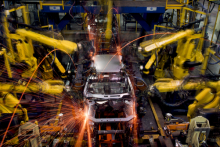
It sounds impressive, was started by a bunch of doctors of philosophy, and it’s imported from Europe. Industrie 4.0, is very fancy and all the rage around in the press that covers the world of industrial automation.
Personally, I think it’s just a giant marketing campaign to stimulate sales of automation control systems. Alleging itself to be a systematic definition of the generations of automation, Industry 4.0 is not a useful framework. It omits several important historical facts, possibly in an effort to be brief, and misses major areas of focus like labor. Work is a human endeavor, and even if you try and engineer out the labor in production, which we are obviously trying to do, some human being has to design, oversee and maintain the systems.
The real focus of Industrie 4.0 is the convergence of Manufacturing and Information Technology. But the resulting conversation is still very narrowly defined in the “Big Data” and “Analytics” hype. This is really what Industrie 4.0 is about, but it’s couched in historical context to make it appear more important.
Large manufacturers have seen this coming for some time. The forces are compelling. Big budgets for automation and IT are expenses that can be leveraged and reduced, so there is a lot of incentive for blending the two roles.
However,Industry (as we spell it here in the US), in its proper context, is about work. If we frame the conversation in terms of how we do work, everything makes a lot better sense. Work 1.0 was when a guy went fishing to feed himself and his family. Or cleared a field and tilled a row of crops with a hoe. Manual labor. We need to remember Work 1.0 because there is always labor involved, craft, artisan, technician, expert, a human being is always involved at some, or many, stages.
Work 2.0 was when we figured out how to harness animals like horses to do work for us. Hence the term Horsepower. Mankind also learned how to harness wind and water to use simple machines that help us do more work with less direct labor. Wind mills to grind wheat and for lifting water to irrigate crops are major transformations that made larger populations possible.
Work 3.0 is the early a less obvious period of the mechanical revolution which has been going on for centuries,. Depending on where you want to pick up the thread of history (pun intended), early mechanical knitting machines were making socks automatically in the mid 1500’s.
Work 4.0 is the classical Industrial Revolution in which steam power unleashes massive mechanical power regardless of location. Steam powers all of the mechanical inventions of previous centuries and enables the invention of new ones. The locomotive engine, steam powered ships on the ocean, create transportation systems that expand our civilization’s range.
Work 5.0 is the electrical age, which is full of irony since steam in one form or another, is the common means of generating electricity. Under the electrical age two other very important improvements take place that wildly increase productivity. The first was the factory method of assembly of the first Ford car plants which caused the car to become less expensive and accessible to a much larger group. Secondly the use of electric relays became a widespread method of controlling equipment automatically.
More next week.